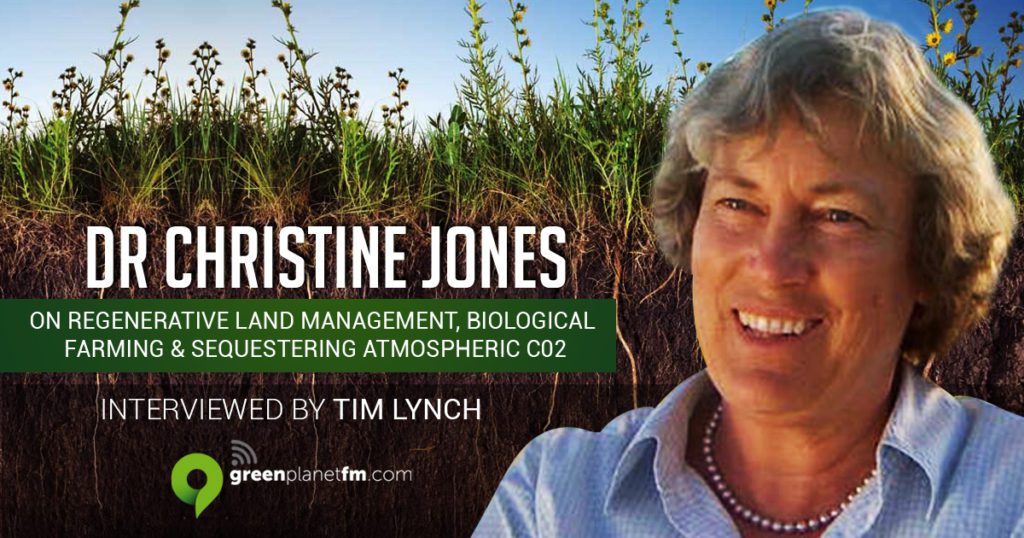
She says improvements to soil function will help restore waterways without any need to reduce the number of cows. At the same time, the cows will be healthier!
Christine has recently returned from New Mexico, USA, where she spoke at the Quivira Coalition Conference. Quivira is broad coalition of environmentalists, ranchers, scientists and public land managers.
Quivira have four broad initiatives:
(1) improving land health;
(2) sharing knowledge and innovation;
(3) building local capacity; and
(4) strengthening diverse relationships.
http://quiviracoalition.org/About_Us/
The reason for this coalition? Ranchers and conservationists were involved in a stand-off. Poorly managed cattle herds were causing deterioration to rangelands. This was not due to the cattle, but rather, to the way they were managed. The Quivira Coalition created a collaborative framework enabling ranchers and range scientists to work together to deliver significant improvements to rangeland health, while at the same time improving economic returns for ranchers.
Here in NZ we have pollutants from dairy farms entering rivers and lakes and damaging the environment. Can we establish an organisation like the Quivira Coalition that fosters meaningful dialogue and promotes innovative ways to manage pastures and soils so that water quality is significantly improved?
Christine says we can, explaining that the natural processes that underpin effective soil function and catchment health are the same processes that make land productive for livestock.
Solving the nitrogen issue is a big challenge for farmers. Not only is excessive nitrogen a problem for waterways, but it is also a problem for cows. Metabolic disorders including mastitis, laminitis and infertility result from elevated blood levels of nitrogen. Some dairy farms in the Waikato have cow infertility rates as high as 30%.
One of the issues facing NZ dairy farmers is the firmly held belief that pastures cannot grow without added nitrogen. Christine explains how this belief came about and what needs to be done to replace nitrogen myths with nitrogen facts.
The atmosphere is 78% nitrogen, which means there are 78,000 tonnes of nitrogen gas sitting above every hectare of land. But not one single molecule of this nitrogen is directly available to plants. To obtain nitrogen, plants must form relationships with nitrogen fixing bacteria - either in the leaves, stems, roots or in the soil close to the roots.
Most free-living nitrogen-fixing bacteria flatly refuse to be cultured in the laboratory, so they don’t have names and we know very little about them. But we do know they can perform the same function as the energy intensive Haber Bosch manufacturing process, seemingly effortlessly.
Where do these bacteria get the energy needed to perform the miraculous transformation of inert nitrogen gas to a potent plant nutrient? From plants. But not if those plants have been fertilised with nitrogen. By adding nitrogen to pastures, we inhibit a natural mechanism that has been operating for millennia.
Around 95% of the life on land is actually in the soil - and most of it is invisible to the naked eye. During the interview, Christine explains the ‘liquid carbon pathway’ by which sunlight energy is transformed to biochemical energy in the form of plant sugars, then transferred to soil microbial communities via plant roots.
North American prairies and African savannas that at one time were incredibly productive in terms of the number of animals they could support, are now less so, due to land managers failing to understand the dynamics of soil and the role of microorganisms such as bacteria and fungi, their complex and mysterious relationships to plant roots and the intricacies of the multiple strands in the web of life.
Most of the dry weight of a plant comes from elements derived from gases in the atmosphere - that is, carbon, hydrogen, oxygen and nitrogen. During the miracle of photosynthesis, plants capture light energy and use it to fuel the processes of assembling themselves from these elements.
Some of the carbon fixed during photosynthesis is also channelled to soil to feed microbes essential to releasing nutrients for plant uptake. Plants communicate with each other - and with microbes and insects - through thousands of different carbon-based chemical signals emitted from their roots and leaves. These chemicals vary over the course of a day and over the seasons, depending on plant requirements.
By channeling carbon to soil microbes, plants also create the aggregates that give soil its structure. Water-stable aggregates are the primary unit of soil function. They affect infiltration (the rate at which soil can absorb water) and the amount of water that soil can hold before it runs off.
It is possible to increase the effectiveness of the rain that falls - and improve production - through improvements to soil structure. The other side of the coin is that soils that lose their life-force also lose the ability to infiltrate and store water. This has resulted in a ‘dewatering’ of land all around the globe. In many countries, more moisture is being lost from land than is received as rain.
Not surprisingly, water vapour is the greenhouse gas that has increased to the greatest extent since the Industrial Revolution. It is a more significant greenhouse gas than carbon dioxide or methane. Further, the presence of water vapour in the atmosphere amplifies the effects of the other greenhouse gases, tripling for example, the effect of carbon dioxide.
Farmers depend on soil for their livelihoods and all of us depend on soil for clean air and water, yet many people have a limited understanding of the profoundly diverse and interconnected ecosystem that is beneath their feet. When we stand on soil we’re standing on the rooftop of another world.
Christine says it is crucial that farmers take the time to go into their paddocks with a spade, dig holes and observe their soils, taking note of the root depth and volume; soil colour, structure and smell; and the presence of earthworms and other critters.
At heart, most farmers want to feel connected to their land, to produce healthy food; and to know that their farm will be resilient in the face of a variable climate. Farmers do not enjoy applying poisons, but the current production model forces them into high chemical use.
It is sobering to reflect that today’s newborn babies come into the world already loaded with hundreds of toxic chemicals and carcinogens. Even the Inuit people of the Arctic Circle, arguably one of the most pristine environments on earth, have extremely high levels of chemical contaminants in their blood.
In New Zealand, the incidence of cancer has dramatically increased from around 1 in a 100, seventy years ago, to today’s situation where almost one out of two people will be diagnosed with cancer in their lifetime. Especially worrying is the elevated incidence of cancer in babies and young children. Medical systems treat the symptoms but not the cause. The cause is the way we produce food.
Why are so many chemicals used in agriculture? Christine says it is because the immune systems of plants no longer function effectively and plants cannot defend themselves from fungal pathogens and insect pests. This places the farmer in the position of needing to use fungicides and insecticides to maintain production. The actual cause of the problem is that in a chemical-farming system, plants lack essential trace elements such as copper, zinc and cobalt, required for self-defense.
These trace elements are lacking because the use of synthetic nitrogen and phosphorus fertiliser reduces the flow of carbon (sugars) from plant roots to soil and results in a decline in the plant-dependent microbial communities that produce the enzymes essential for making trace elements available. It’s a vicious cycle that can only be broken by reducing synthetic fertiliser use.
The situation could easily be changed. All that is required is to stop using synthetic fertilisers and transition to biological products. Farmers will not lose production. Indeed, they will be more profitable due to reduced vet bills and reduced need for fungicides and insecticides. The quality of the food produced will also be markedly improved
Fortunately the paradigm is changing and more and more farmers are realising that nature is under assault. They realise they’ve been told lies by companies peddling chemicals and the time has come to urgently address the issue.
Christine says that when farmers transition to biological farming it is quite an awakening. There is often a sudden realisation they’ve been conned for years and years - for several generations in some cases - and when they’re shown another way it’s oh wow … an opening up to a deeper understanding of their connection to the land, the elements and their sustainer, soil.
Indeed, it was not that long ago that farmers were far more closely connected to the land - they would smell the breeze, watch the weather barometer going up and down, look at the sky more, feel and smell moisture in the air, notice bird migrations and somehow feel more embedded in the localised ecosystem. When today’s high-input chemical farmers transition to biological farming, they re-establish a connection with the natural processes that bring a sense of fulfilment and wellbeing.
You can see it in their faces, you can see it in their animals and you can see it in their pastures. When people look after and nourish their soil, the soil responds in kind.
There are no downsides to transitioning to biology-friendly and fish-friendly farming. It is an approach based on the web of life rather than the web of death.
The reason NZ farmers are reluctant to make these changes is because they’ve been programmed with misinformation.
But once people realise it’s the life in the soil under their feet that determines the productivity of their land, whether they’re producing milk, meat, vegetables, fruit, grains or wool, they soon want to learn more about how soil functions.
The only tools required to increase one’s understanding of soil are a spade, an open mind and a refractometer to measure Brix (a determination of the amount of dissolved solids in the sap, which indicates how fast plants are photosynthesising).
Christine says there are so many exciting possibilities for the future of farming. The more we understand soil processes the more we realise its very much a case of ‘as above so below’. Within the invisible realms of the soil ecosystem, life is conspiring to renew and revitalise and restore the connection between farmers and their land and animals. Life has a determination to flourish but we keep getting in the way.
Christine will be heading up a national research project initiated by AgriSea NZ, working alongside high-input dairy farmers interested in transitioning to biology-friendly methods of restoring their land and increasing the health of their livestock. A unique feature of this world-class program will be the underwriting by AgriSea of any potential loss of production by participating farmers. Christine adds with a laugh, they might have to include another clause to the effect that farmers will have to pay AgriSea when their production increases. See http://agrisea.co.nz
For Christine’s articles on soil health, see www.amazingcarbon.com
